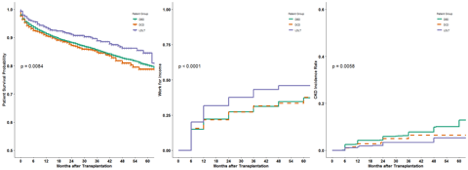Live Donor Liver Transplant Offers Higher Survival, Improved Quality of Liver and Lower Morbidity for Recipients with Low MELD Score
Baylor University Medical Center, Dallas, TX
Meeting: 2020 American Transplant Congress
Abstract number: B-160
Keywords: Liver cirrhosis, Liver transplantation, Living donor, Morbidity
Session Information
Session Name: Poster Session B: Liver: Living Donors and Partial Grafts
Session Type: Poster Session
Date: Saturday, May 30, 2020
Session Time: 3:15pm-4:00pm
 Presentation Time: 3:30pm-4:00pm
Presentation Time: 3:30pm-4:00pm
Location: Virtual
*Purpose: The shortage of cadaveric liver grafts contributes to significant waitlist mortality. Patients with low MELD-Na score (<22) have lower rates of transplant and are at particular risk for death. We examined whether early transplant with living donor liver transplant (LDLT) as compared to cadaveric donors may lead to improved mortality and morbidity after LT.
*Methods: We examined all patients that underwent LT between 2012-17 using SRTR data (n=25,151). Patients were categorized into Na-MELD groups (<15, 15-22, >22), and sub-grouped by liver graft: DBD, DCD, or LDLT. Primary outcomes was patient survival; secondary outcome was readmissions, new onset CKD and return to work after LT.
*Results: LDLT demonstrated a survival advantage over DBD and DCD donors (p<0.01), particularly for MELD <15, while survival was similar to DBD for MELD 15-22 (Figure 1a). Readmission rates were similar; however, more LDLT patients returned to work post-transplantation (p<0.01) (Figure 1b) and had lower incidence of chronic kidney disease (p<0.01) (Figure 1c) when compared to DBD and DCD recipients.
*Conclusions: LDLT offers a survival benefit over DBD and DCD grafts. Furthermore, LDLT results in improved return to work and renal function post-transplant, which may lead to an improved QoL. These results strongly favor increased early LDLT as a strategy to improve morbidity and mortality for low MELD patients in the face of a national organ shortage.
Figure 1. a) 5-year patient survival is superior after LDLT when compared to DCD and DBD donors. b) More patients return to work following LDLT when compared to DCD and DBD donors. c) Incidence of CKD is less at 5-years after LDLT when compared to DCD and DBD donors.
To cite this abstract in AMA style:
Black M, Bayer J, Fernandez H, Martinez E, McKenna G, Onaca N, Ruiz R, Testa G, Wall A, Ma T, Saracino G, Asrani S, Gupta A. Live Donor Liver Transplant Offers Higher Survival, Improved Quality of Liver and Lower Morbidity for Recipients with Low MELD Score [abstract]. Am J Transplant. 2020; 20 (suppl 3). https://atcmeetingabstracts.com/abstract/live-donor-liver-transplant-offers-higher-survival-improved-quality-of-liver-and-lower-morbidity-for-recipients-with-low-meld-score/. Accessed December 30, 2025.« Back to 2020 American Transplant Congress

